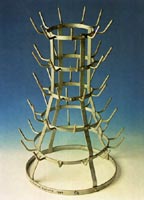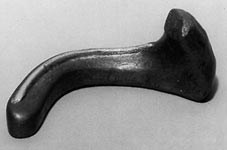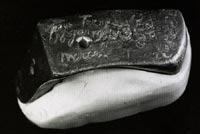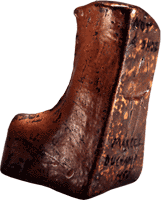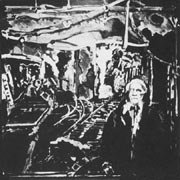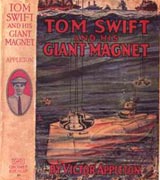"A very normal guy" Robert
Barnes on Marcel Duchamp and Étant Donnés
Tout-Fait: In this case it was the Greek collector Dimitri Daskalopoulos, actually. Why would you think it is impossible for a lot of people to succeed in doing research on the original ready-mades --which Duchamp supposedly bought from stores--scholars like Thomas Zaunschirm or William Camfield writing an entire book about Fountain, or Kirk Varnedoe in 1990/1991, doing the High and Low: Modern Art & Popular Culture show at the Museum of Modern Art trying to find the original Comb (Fig. 18). Rhonda Roland Shearer is continuing to track down the original objects but you just can't find them, even in the catalogues. Why would that be? Robert Barnes: Because they're old junk. They're old junk that lasts, pal. Tout-Fait: Yeah, but the old catalogues, from the ‘10s and ‘20s, you should be able to find those things. Robert Barnes: You've got the wrong catalogues, old catalogues get thrown away. But I just this love this business, "Oh, The urinal is a fountain of some…" I mean art historians are bizarre. And again, I'm sure Marcel would be totally amenable to helping them create these bizarre attitudes, because it is again the transit of the thing into something else. It is transmuted and changed into something else. And certainly art history, if anything, transmutes art into something useless. Tout-Fait: Art history keeps artists alive and Duchamp was always more interested in the audience that came after than in his contemporaries. Robert Barnes: Self-glorification is what art history is about and "I have discovered this," or "This is my area." Crazy nitwits. "Duchamp is my area." That's goofy. But Duchamp would love that. He would love to have himself be their "area." If there were any good looking ones, he'd like that too. But the whole idea of the transformation … mystery, transformation, and manipulations--those were the things that Marcel was a magician at. That's his magic. Tout-Fait: Paul Matisse, who assembled Étant Donnés, in the Philadelphia Museum of Art, suggested that no one knew about the piece except Duchamp's wife, Teeny, Duchamp himself, of course, and Maria Martins. Robert Barnes: Well maybe it helped to sell it to people, make it more exotic. Tout-Fait: When Bill Copley purchased Étant Donnés through his Cassandra Foundation (9), he knew about it too, so it wasn't that big of a big secret. He purchased it and then gave it to the Philadelphia Museum of Art. Now, we just talked about the erotic objects that were coming out in the ‘50s. When you read reviews--and those people didn't know about Étant Donnés in the making--they were, for example, described by the New York Times as "bizarre artifacts," sexual objects of some sort. They didn't know what to make of them.
Robert Barnes: The Great Glass was a bizarre sexual object. Tout-Fait: Almost everything, even the Bottle Rack (Fig. 19). Robert Barnes: These were the horniest people on earth in an age where we were allowed to be horny without being arrested or sued. Tout-Fait: I know, it's a little sad nowadays. The first thing, even before he made the Female Fig Leaf, the Objet-Dard or Wedge of Chastity (Figs. 20, 21) --which he gave to Teeny as a wedding present--before all that he had already made the wedge section of the Wedge of Chastity, the inner sanctum of the Female Fig Leaf cast, if in fact it was a cast. It's titled Not a Shoe (Fig. 22) and he gave it to Julian Levy (10) in 1950. Those two were pretty close, right?
Robert Barnes: Yes, Levy was very much like Marcel. They were very close in character. We used to call him the "Jewish Marcel Duchamp." But he was a remarkable person in his own right. I always thought that it was sad that Julian did not make art. In the end, he did make videos. There are several of them around. I did a painting, an imaginary portrait of Alfred Stieglitz in 1966 (Fig. 23), that Julian liked and bought. It was reproduced in Julian's book Memoir of an Art Gallery and it was such a surprise to see it in there again. It is not a bad painting I guess. I once also did a portrait of Julian from memory that his wife Jean thought very accurate. It showed him with his fly open, which Julian was prone to have. He was phenomenal. Actually I had quite a falling out with Julian because he wanted me to illustrate Jacob Again, a book he wrote, a semi-science fiction thing. And the truth is that it wasn't very good and I couldn't illustrate it and I doodled around but Julian got impatient with me. I didn't know what to say.
Tout-Fait: Talking about semi-science, you said there were teenage books that you and Duchamp shared a passion for. Robert Barnes: Oh, yeah, no one knows about that, do they? Tom Swift and the Giant Magnet (Fig. 24). Tom Swift was a character, I don't know who wrote them, but they were great children's books (11). Tout-Fait: So you were reading them at the time? Robert Barnes: No, we both knew about them. I don't know if they got translated into French or where he came across them. He probably found them in the Strand Bookstore or something. Tout-Fait: How did you get to talk about that? Robert Barnes: I don't know how. Maybe I mentioned that some of his things were like the inventions of Tom Swift. Tom Swift was a great inventor, probably much better than Marcel. Some Duchamp scholar should read Tom Swift to see if there's any correlation with anything Tout-Fait: When would Duchamp have first come across the Tom Swift books? Robert Barnes: Well, I don't know. Tom Swift books were popular in the ‘30s and ‘40s and probably even the '50s. Tout-Fait: Coming back to the surrealists you knew, Max Ernst was the earliest "acquaintance." You said you ran away from home when you were 15, and you ran into him in Arizona where he resided with Dorothea Tanning between 1946 and 1953. Robert Barnes: In Sedona. I didn't know who the hell he was.
Notes
Figs.
18-22
|
||||||||||||||||||||||||||||||||

